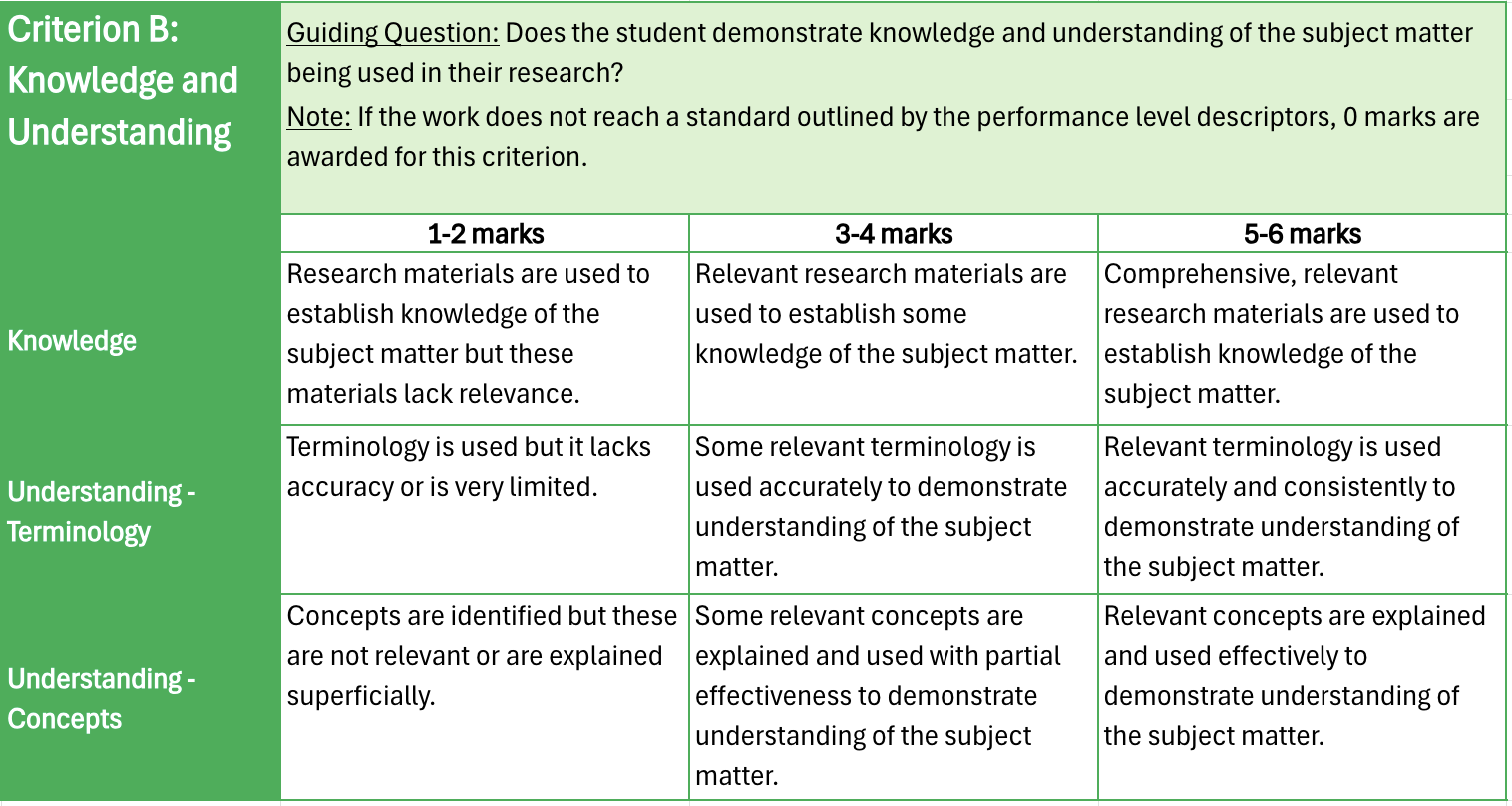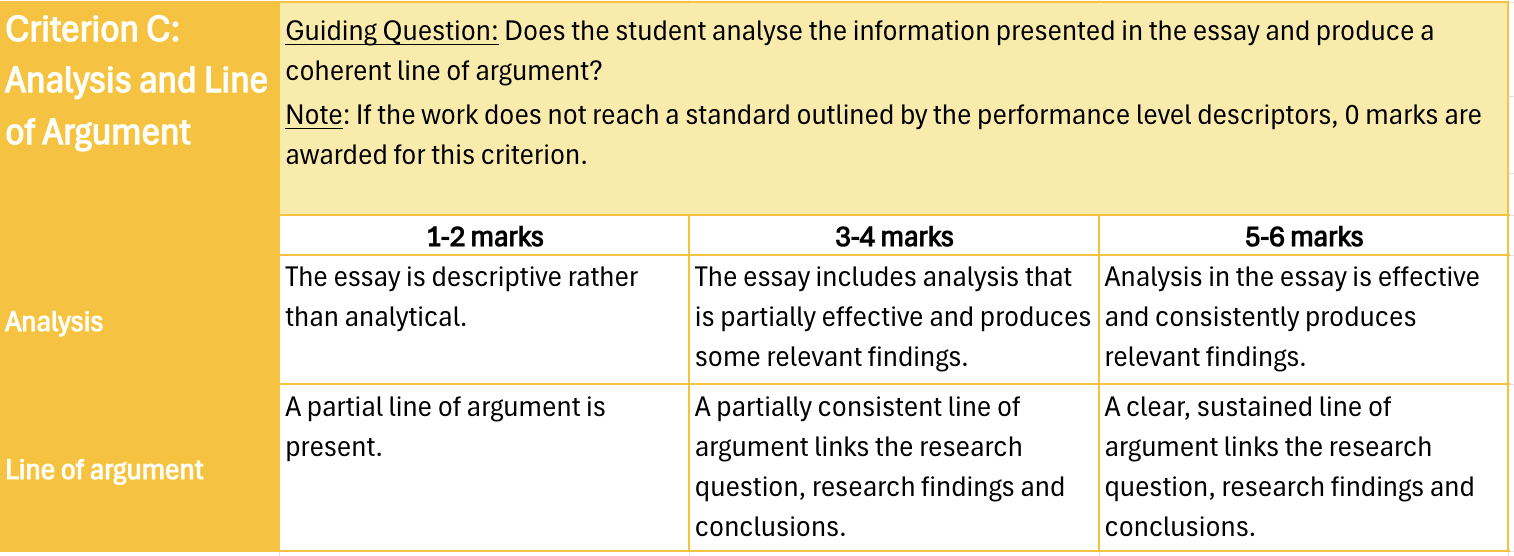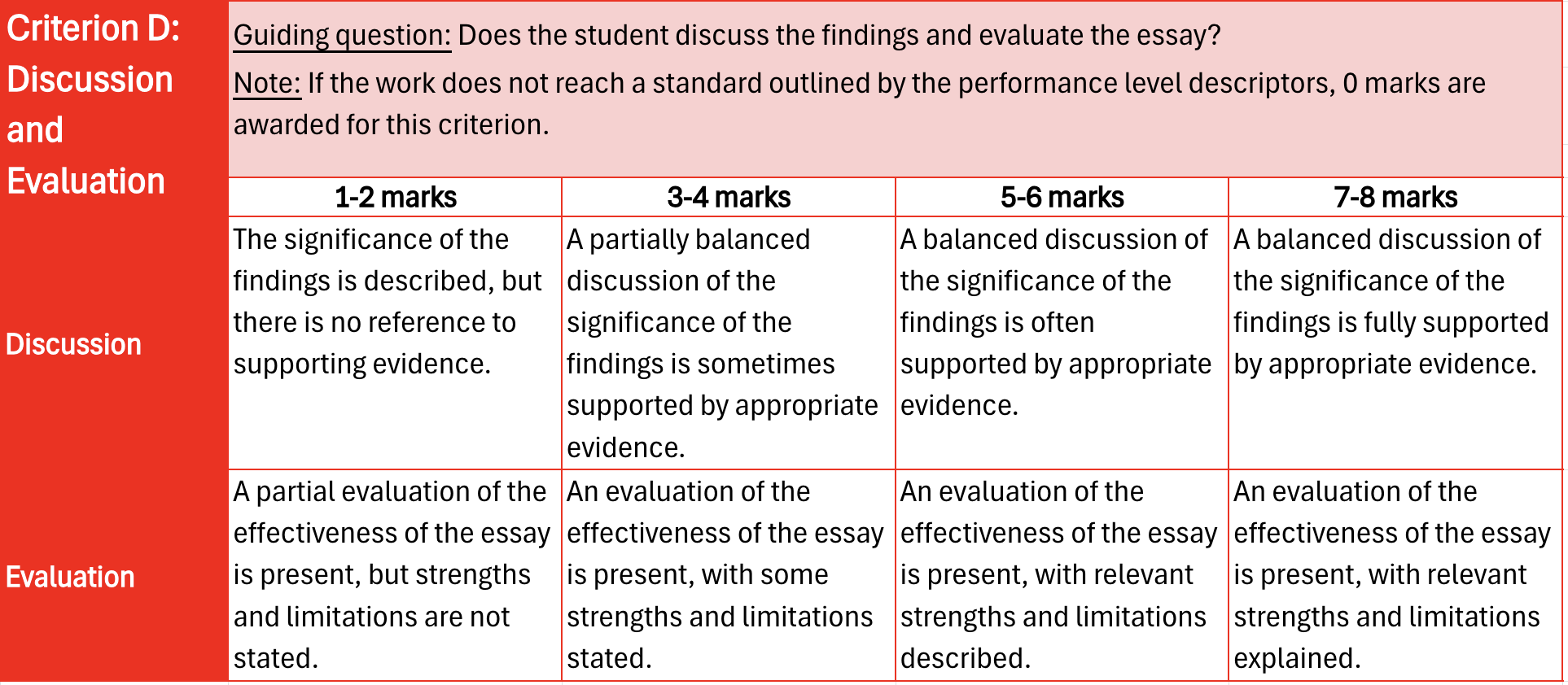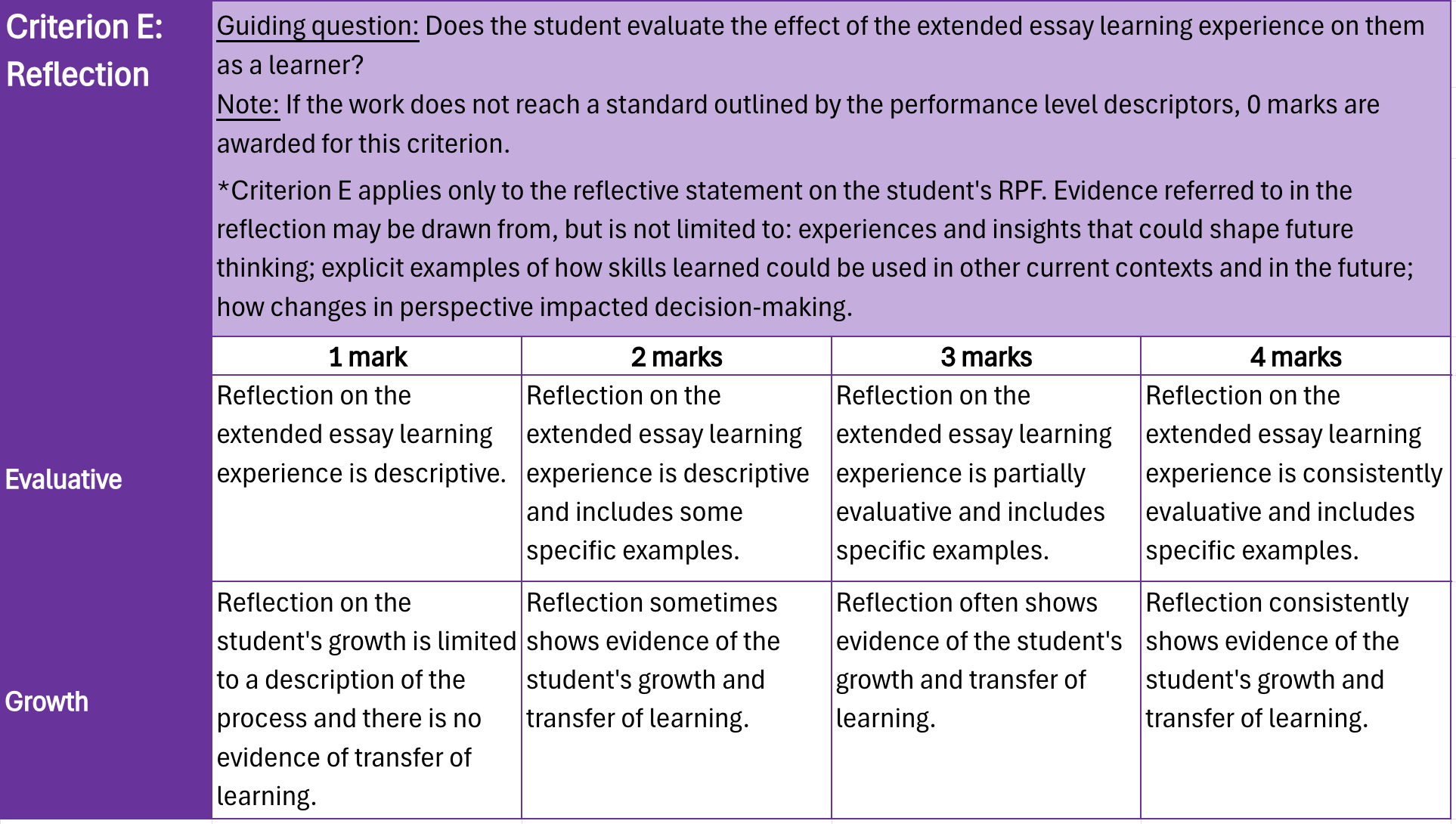

Click on the EE SUBJECTS tab above for more specific "Considering the Assessment Criteria" by subject.
How the assessment criteria are applied
Examiners mark positively, giving credit where appropriate for what students have written, rather than looking for omissions. Their aim is to find the level descriptor that conveys most accurately the level attained by the student's work, using the best-fit approach. A best-fit approach means that compensation should be made when a piece of work matches aspects of different markbands. The mark awarded should be one that most fairly reflects the balance of achievement against the markband. It is not necessary for every indicator within a markband to be met for a mark to be awarded in that markband. Awarding the top mark does not imply faultless performance.
Note: Criteria A, B, C and D are applied to the extended essay as a whole. Criterion E is applied only to the reflective statement on the student’s RPF.
Assessment Objectives:
Knowledge & Understanding
Application & Analysis
Synthesis & Evaluation
Communication of Research
EE Guide pg 111-114

Questions to ask yourself:
Research Question
Research Methods
Structure

Questions to ask yourself:
Knowledge
Terminology
Concepts

Questions to ask yourself:
Analysis
Line of Argument

Questions to ask yourself:
Discussion
Evaluation
*There is more detail in the Reflection tab above.

Questions to ask yourself:
Evaluative Reflection
Growth and Transfer
Your extended essay should be clearly written in a formal academic style, appropriate to the subject(s) from which the topic is drawn. Given that the extended essay is a formally written research paper, it should strive to maintain a professional, academic look.
To help achieve this, follow this formatting guidance.
Submitting your extended essay in the required format will help set the tone of the essay and will aid readability for on-screen assessment by examiners.
Overall structure
 The structure of your essay is very important because it helps you to organize your line of argument.
The structure of your essay is very important because it helps you to organize your line of argument.
The following structural conventions must be present in the essay you submit for assessment.
In addition to the recognized structure of any extended essay, as above, it is also important to incorporate any structural conventions that relate to the subject(s) you are using.

Word counts
The upper limit for all extended essays is 4,000 words. Note that examiners are instructed not to read or assess any material in excess of the word limit.
This means that essays containing more than 4,000 words will be negatively compromised across all assessment criteria. You should therefore ensure that your essay remains within the word limit. If the word count of your final draft is over 4,000 words you should edit it down accordingly.
The table below provides specific guidance on the content that is and is not included in the word count.
| Included in Word Count | NOT Included in Word Count |
|---|---|
| The Introduction | Table of Contents |
| The Body | Headers (next to pg #) |
| The Conclusion | Maps, Charts, Diagrams, Annotated Illustrations |
| Quotations | Tables |
| Footnotes (that are not citations) | Equations, Formulas & Calculations |
| Section headings in the text | Citations: paranthetical, numbered, or footnotes |
| The Bibliography | |
| The Reflection |
Students writing in Chinese, Japanese or Korean
Students writing their extended essay in Chinese, Japanese or Korean should use the following conversions.
When typing in Chinese, Japanese or Korean, word processing software is likely to include the number of characters and punctuation in the word count. Students should not include punctuation in the word count for assessed work. The word count should only reflect the number of characters typed.
EE Guide pg 87-92
Grade A
• The student demonstrates effective research skills, resulting in a well-focused and appropriate research question that can be explored within the scope of the chosen topic.
• There is effective engagement with relevant research areas, methods and sources.
• There is excellent knowledge and understanding of the topic in the wider context of the relevant discipline.
• There is effective application of source material and correct use of subject-specific terminology and/or concepts that further supports this.
• Conclusions are consistent, relevant and proficiently analysed.
• Arguments show sustained reason and are supported effectively by evidence.
• Research is critically evaluated.
• Coherence, consistency and effective use of structural conventions support readability to an excellent degree.
• Reflection on the extended essay learning experience is consistently evaluative and includes specific examples.
• Reflection shows consistent evidence of the student’s growth and transfer of learning.
Grade B
• The student demonstrates appropriate research skills, resulting in a research question that can be explored within the scope of the chosen topic.
• There is reasonably effective engagement with relevant research areas, methods and sources.
• There is good knowledge and understanding of the topic in the wider context of the relevant discipline.
• There is a reasonably effective application of source material and reasonable use of subject-specific terminology and/or concepts.
• Conclusions are consistent and accurately analysed.
• Arguments show reason and are often supported by evidence.
• Research at times shows critical evaluation.
• Coherence, consistency and use of structural conventions support readability to a good degree.
• Reflection on the extended essay learning experience is partially evaluative and includes specific examples.
• Reflection often shows evidence of the student’s growth and transfer of learning.
Grade C
• The student demonstrates evidence of research undertaken, leading to a research question that is not necessarily expressed in a way that can be explored within the scope of the chosen topic.
• There is partially effective engagement with mostly appropriate research areas, methods and sources. However, there are some discrepancies in those processes, although these do not interfere with the planning and approach.
• There is some knowledge and understanding of the topic in the wider context of the discipline, and the knowledge is mostly relevant.
• There is an attempted application of source material and appropriate terminology and/or concepts; an attempted synthesis of research results with partially relevant analysis.
• Conclusions are partly supported by the evidence.
• Arguments are descriptive rather than analytical.
• There is a partially successful evaluation of the research.
• The essay is not always coherent and consistent, and structural conventions are irregularly applied, but this does not significantly hinder readability.
• Reflection on the extended essay learning experience is descriptive and includes some specific examples.
• Reflection sometimes shows evidence of the student’s growth and transfer of learning.
Grade D
• The student demonstrates a lack of research, resulting in unsatisfactory focus and a research question that is not answerable within the scope of the chosen topic.
• At times, there is engagement with appropriate research, methods and sources, but discrepancies in those processes occasionally interfere with the planning and approach.
• There is some relevant knowledge and understanding of the topic in the wider context of the discipline but at times the knowledge is irrelevant.
• There is an attempted application of source material but with inaccuracies in the use of, or underuse of, terminology and/or concepts.
• There is irrelevant analysis and inconsistent conclusions as a result of a descriptive discussion.
• There is a lack of evaluation.
• The limited coherence and consistency of the essay and absence of structural conventions hinders readability.
• Reflection on the extended essay learning experience is descriptive.
• Reflection on the student’s growth is limited to a description of the process and there is no evidence of transfer of learning.
Grade E (a failing condition)
• The student demonstrates little or no research, a lack of focus and an ineffective research question.
• There is a generally unsystematic approach and a resulting unfocused research question.
• There is limited engagement with limited research and sources.
• There is generally limited and only partially accurate knowledge and understanding of the topic in the wider context of the discipline.
• There are ineffective connections in the application of source material, and inaccuracies in the terminology and/or concepts used.
• The results of research are summarized with inconsistent analysis.
• There is an attempted outline of an argument but one that is generally descriptive in nature.
• The lack of coherence and consistency and absence of structural conventions significantly hinders readability.
• Reflection on the extended essay learning experience is very limited, with no evidence of transfer of learning.
EE Guide p.115-117